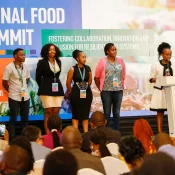
SUSTAINABLE FOOD SYSTEM: WHICH IS THE RIGHT WAY?
Food is one of the basic needs in life. Every human being, regardless of social status and geographic location, needs food to survive. Even though some foods are manufactured using modern technology, they still rely on raw materials from agriculture as they are bound by the laws of physics; hence, they can produce something from nothing (Thorpe, 2020). This means human beings still have to rely on agriculture for survival and have to find the most sustainable approaches and methods.
The major part of agricultural land in the world is farmed by smallholder farmers. In the developing world, for example, smallholders produce the bulk of the food that is consumed. In Africa, Kenyan and Tanzanian small farmers produce 63 and 69 per cent of the food in the country, respectively (Rapsomanikis, 2015). It is, therefore, important that the agricultural actions adopted by various nations and conventions take into consideration the specific needs and interests of smallholder farmers, or else the world risks facing a higher level of food insecurity. This issue should be considered with the urgency it deserves, especially basing it on the growing rate of the world population, which is expected to reach 10 billion in 2050 (True Cost Initiative, 2022).
What is the current state?
Conventional agriculture, which relies on the formal seed sector and chemical-intensive inputs, is only realistic for a small number of crops and a few countries (Almekinders & Louwaars, 2002). This type of agriculture is not environmentally friendly as it negatively impacts soil organic matter content and biological activity, soil structure, and plant and animal biodiversity, and also causes pollution (Kasperczyk & Knickel, 2006). It, in turn, results in increased greenhouse gas emissions while reducing the chances of contributing to carbon sink and carbon sequestration. There is a need to reduce greenhouse gas emissions from agriculture if we are to win the fight against climate change. This is because the agri-food sector is the primary driver of biodiversity loss globally. It is responsible for 70% of all freshwater withdrawals from the natural cycle and 31% of human-caused Greenhouse Gas (GHG) emissions (True Cost Initiative, 2022). The decision on the most appropriate agricultural approach should, therefore, go beyond consideration of the economies of production to the people involved and the possible impact on the health of planet Earth.
The true cost of conventional versus organic farming
Organic farming is characterized by lower yields and input use, as well as higher output prices compared to conventional systems (Durham & Mizik, 2021). The difference in yields is not so huge as organic yield stands at 10% lower than conventional farming (MacRae, Brenda, & Ralph, 2007). Beyond the economic value of the two farming approaches, organic farming comes with environmental benefits like improved soil health, lower CO2 emissions, better carbon sequestration, long-term sustainability, and improved water quality due to diminished pesticide residues (Nguyen, Allen, W, Danielle, & T, 2008; Uematsu & Mishra, 2012).
Based on the above statements, it is important that the true cost of different approaches takes into consideration the underlying costs and benefits. The true economics of agriculture can only be understood after recognizing and accounting for all significant “externalities,” as this shows hidden costs and benefits of agriculture and food systems incurred to feed the growing population (The Economics of Ecosystems and Biodiversity (a), n.d.). This calls for holistic evaluation while using natural capital, human capital, and social capital indicators to analyze the environmental impacts, economic impact, social impact, and health impact.
Natural capital includes climate, greenhouse gases, carbon stock, soil erosion, soil organic matter buildup, water stress, water pollution, and ecosystems. Human capital focuses on human health, including human toxicology leading to diseases like cancer, worker remuneration, working conditions such as occupational health and safety, and excessive working hours. Social capital is based on gender equality, such as the gender pay gap, and human rights violations, including forced labour and child labour (True Cost Initiative, 2022).
Nations are spending a lot on mitigation actions. This cost could be reduced if mankind could adopt agricultural approaches that reduce greenhouse gas emissions and increase carbon sequestration. The number of years required to sink or sequester greenhouse gases could also be reduced. A lot of funds that could have been used for climate finance and humanitarian assistance are used to treat medical conditions resulting from conventional agriculture. Recognizing and accounting for the negative and positive environmental, social, and health externalities of food and agricultural systems is a significant contribution toward the creation of healthy and sustainable food systems (Eigenraam, McLeod, Sharma, Obst, & Jekums, 2020).
The formula that relies only on monetary value and labour for calculating the true cost and benefits of different farming approaches is misleading. In reality, cheap food is very expensive. Our food bill is not only paid for at the market or supermarket but also in the additional—and largely unaccounted for—costs of climate change and biodiversity loss. Hence, there is a need to name the true cost of cheap food (True Cost Initiative, 2022). Accounting should focus beyond the current cost to those that will be paid by future generations. This will give the real picture of the true cost and benefit of different agricultural approaches.
Case studies on the true cost of different approaches:
We spoke with Kibet Kipsang, a Kenyan youth small-scale organic farmer. Kibet is from the Ogiek Peoples, Indigenous Peoples who originally inhabited Mau Forest and were hunters and gatherers. The community was evicted from the forest and is currently scattered in various parts of the country, including Ravine-Baringo County, Kericho County, Cherangani Hills-Tranzoia County, and Mt Elgon. They have been assimilated into mixed farming, including crop farming. Apart from being a farmer, Kibet is an organic agriculture champion. He does this through his work with the Ogiek Youth and Women Network.
Kibet shared his organic farming story. He mentioned the time when he gave his farm to a family member. This member, while trying to avoid the intensive labour believed to come with organic farming, used a chemical spray to clear the farm. This resulted in low production because of the chemical depleted soil nutrients. Apart from the low yield, he has been forced to leave the land fallow while applying organic manure to enable soil health recovery. According to him, this is proof of how chemical inputs can disrupt the food value chain and how costly the actions can be.
Kibet’s story is not very different from that of the Andhra Pradesh community, as reported in a study by the Global Alliance for the Future of Food. The study assessed the true costs and benefits of natural farming compared to other farming methods by measuring major economic, social, and health impacts. It compared chemical farming in the Godavari delta region, rainfed farming in the semi-arid region, and low-input tribal farming in the mountain region. The results provide strong evidence that natural farming offers a better alternative to existing farming systems. It leads to greater crop diversity, similar or higher yields, higher incomes for farmers, lower input costs, improved local economies, enhanced social networks, improved health, and reduced health costs.
Which Way?
Agricultural actions should consider the true costs and benefits of different agricultural approaches for both the human race and the planet, both now and in the future. Based on the above analysis, this calculation will result in higher acceptance and adoption of natural or organic farming approaches as it will highlight the significant benefits of organic or natural farming. Natural and organic farming approaches exist in various forms and names, including regenerative farming, diversified farming, and agroecology. These approaches mainly rely on farmer seeds, which are easily accessible to the majority of small-scale farmers. Farmer seeds can be reproduced, something not possible with formal seeds. This makes farmer seeds the preferred option for small-scale farmers, the majority of whom cannot afford to buy seeds every planting season. Farmer seeds are resilient to local weather, an important consideration given the persisting climate change and the existence of extreme weather conditions in most parts of the world.
Small-scale farmers relying on farmer seeds can make use of bio-inputs such as bio-fertilizers and biopesticides to increase yields. Bio-inputs are products made from beneficial organisms such as bacteria, fungi, viruses, and insects, or natural extracts obtained from plants, that can be used in agricultural production to control pests or promote the development of plants. These products do not leave toxic residues in the environment, and their use does not imply risks to the health of farmers and consumers (Protergium).
Several organizations are currently producing bio-inputs. In Kenya, the Resource Oriented Development Initiative (RODI) produces Bokashi Biofertilizer, Super magro-liquid fertilizers, Vermi liquid seed dresser and folia feed, and Ash brew for insects and pest control. Another Kenyan organization involved in the bio-input business is the Effective IPM Association, which offers packaged biostimulants from seaweed. In Uganda, the Biofertilizer Centre for Youth Empowerment, led by Lynnet Nakidde and located in Masaka, produces Bokashi fertilizer. These are just a few examples of organizations working towards the production of bio-inputs to support the natural farming system. Unfortunately, these stakeholders rarely receive support from governments to subsidize the cost of production, which could result in cheaper final products and lower production costs for small-scale farmers. Governments should consider supporting bio-input producers when issuing subsidies to agricultural input producers.
At the farmer level, those engaged in natural or organic farming are forced to spend more on insurance than conventional farmers. This has made insurance services inaccessible to most small-scale farmers. The high cost of insurance services is fueled by the belief that natural or organic farming is risky due to the lack of consistent inputs. Organizations working on bio-inputs and data on success stories of these inputs should be used to debunk this myth.
Whenever governments issue subsidized inputs, bio-inputs are not considered, leaving out the small-scale farmers who rely on farmer seed and those practising organic or natural farming. Consequently, a significant population that plays a crucial role in food security is left behind, which diminishes the effectiveness of the subsidies. It is important for governments to consider subsidizing not only chemical agricultural inputs but also bio-inputs. In fact, a greater proportion of agricultural subsidies should be allocated to bio-inputs if we are to achieve sustainable agriculture for humankind and the planet.
The use of bio-inputs is not only important due to the smallholder farmers’ preference and their positive impacts on the environment and climate change, but also because it provides a more reliable option, considering the increased prices of petroleum substances that have affected the supply and price of common nitrogen fertilizers like urea (Mohite, et al., 2019). Most, if not all, conditions for achieving food security through sustainable agriculture point towards the adoption of natural or organic farming and, by extension, the use of bio-inputs.
References
Almekinders, C. J., & Louwaars, N. P. (2002). The Importance of the Farmers’ Seed Systems in a Functional National Seed Sector. Journal of New Seeds, 15 – 33.
Capitals Coalition. (n.d.). Food System Transformation. Retrieved June 16, 2023, from Capitals Coalition: https://capitalscoalition.org/project/teebagrifood-for-business/
Durham, T. C., & Mizik, T. (2021). Comparative economics of conventional, organic, and alternative agricultural production systems. Economies, 9(2), 1 – 22.
Eigenraam, M., Mcleod, R., Sharma, K., Obst, C., & Jekums, A. (2020). Applying the TEEBAgriFood Evaluation Framework: Overarching Implementation Guidance. Global Alliance for The Future Of Food.
Global Alliance for Future of Food. (n.d.). Assessing Natural Farming through a wider lens: insights from India .
Kasperczyk, N., & Knickel, K. (2006). Environmental Impacts of Organic Farming. In P. Kristiansen, Organic agriculture: a global perspective (pp. 259 – 282). CSIRO.
MacRae, R. J., Brenda, F., & Ralph, C. M. (2007). Economic and social impacts of organic production systems. Canadian Journal of Plant Science, 87, 1037 – 1044.
Mohite, B., Koli, S., Borase, H., Rajput, J., Narkhede, C., Patil, V., & Patil, S. (2019). New Age Agricultural Bioinputs. In D. P. Singh, V. K. Gupta, & R. Prabha, Microbial Interventions in Agriculture and Environment. Research Trends, Priorities and Prospects (Vol. 1, pp. 353 – 380). Springer.
Nemes, N. (2009). Comparative analysis of organic and non-organic farming systems: a critical assessment of farm profitability. Rome : Food and Agriculture Organization.
Nguyen, T., Allen, W, Danielle, & T. (2008). Economics of the Organic Food Industry in Florida. Gainesville: IFAS Extension.
Protergium. (n.d.). Bio Inputs. Retrieved June 16, 2023, from Protergium: https://protergium.com/bio-inputs/
Rapsomanikis, G. (2015). The economic lives of smallholder farmers. An analysis based on household data from nine countries. Rome : Food and Agriculture Organization.
The Economics of Ecosystems & Biodiversity (b). (n.d.). The Evaluation Framework. Retrieved June 16, 2023, from https://teebweb.org/our-work/agrifood/understanding-teebagrifood/evaluation-framework/
The Economics of Ecosystems and Biodiversity (a). (n.d.). Agrifood. Retrieved June 16, 2023, from Teebweb: https://teebweb.org/our-work/agrifood/
Thorpe, T. (2020, January 24). Food without farming? Retrieved June 16, 2023, from The Ecologist : https://theecologist.org/2020/jan/24/food-without-farming
True Cost Initiative . (2022). True Cost Accounting Agrifood Handbook: Practical guidelines for the food and farming sector on impact measurement, valuation and reporting. Soil & More Impacts.
Uematsu, H., & Mishra, A. K. (2012). Organic farmers or conventional farmers: Where’s the money? Ecological Economics, 78, 55 – 62.



